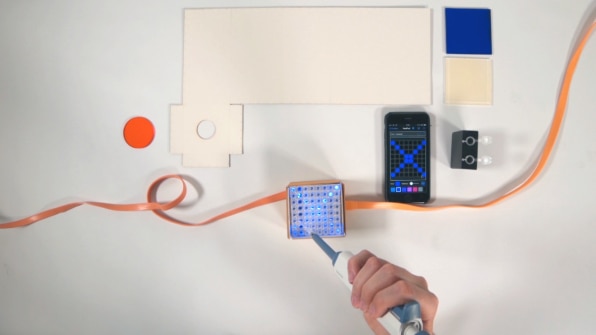Bio-Designing with MIT Media Lab
In the course of recent years, a gathering of analysts at the MIT Media Lab have planned exercise garments and running shoes made with texture with pores that open when you sweat, utilizing microscopic organisms that agreement in muggy conditions.
Be that as it may, few out of every odd fashioner can design microscopic organisms. It takes an immense measure of specialized know-how to make these sorts of materials. That is the reason MIT Media Lab alum and architect Helene Steiner, who took a shot at the first venture, spun off and made her own particular organization called Cell-Free Tech with the objective of making biodesign more available.
Today, Steiner and her three fellow benefactors are propelling their first item: Bixels, an extremely essential DNA PC with an organic show.

Here’s the basic form of how it functions. DNA is the natural rendition of code. Each phone has a scaled down “assembling plant,” as Steiner calls it, that takes the directions from the DNA and produces things like proteins and catalysts. The Cell-Free Tech group has taken these assembling plants, called ribosomes, out of their phones. From that point, they can bolster them any DNA they need. For this situation, they’re nourishing them the DNA code to make green fluorescent protein that can be found in jellyfish.
The DNA preparing works somewhat like a Gameboy, Steiner clarifies. The assembling plant won’t do anything unless you opening in a “cartridge”– the DNA– which will enable you to play one kind of amusement (or make one sort of protein). Be that as it may, there are a variety of recreations (and proteins) you can play.

Bixels, which dispatches on Kickstarter today, is practically similar to a genuine form of Steiner’s Gameboy allegory for DNA. Their organic mixed drink made of the ribosomes (Steiner calls it a phone smoothie) sits in each of the 64 “bixels” on the little gadget’s show. You can utilize an application to “turn on” each point– an electronic flag makes a LED illuminate, which thus invigorates the assembling plants to make their protein. To the human eye, the proteins shine green, and you can program them to illuminate with certain patterns– or even utilize them to play a session of bio-Tetris.
Bixels comes as a level pack unit that you can overlap together alongside the cell smoothie, a fundamental electronic circuit, and DNA. It’s essentially an instructive tool– however not for youthful youngsters, regardless of whether Steiner says that an extremely improved rendition could be utilized as a part of the classroom. It’s more for more seasoned understudies, similar to the ones that Steiner instructs at the Royal College of Art in London. She as of late did a workshop utilizing Bixels to show mold outline understudies about biodesign and how they could join natural materials into the garments they make. The understudies had no involvement with either science or hardware. “Individuals stated, no chance, it’s unimaginable that I can do this,” Steiner says. Be that as it may, before the finish of the workshop, “individuals truly began examining how they’d jump at the chance to utilize it: to incorporate into strands, make embellishments, how it could respond to demonstrate your pH.”

At the present time, you control Bixels utilizing an off-the-rack application, which gives you a chance to draw pictures and make designs utilizing the natural Gameboy. In the event that the Kickstarter crusade is fruitful, the group will have the capacity to make their own custom application.
The item discharge will likewise fuel the group’s own examination into biomaterials, especially around utilizing the without cell organic concentrate that is utilized as a part of Bixels to configuration savvy materials and materials. Yet, there are likewise applications in encouraging other biotech inquire about. “It can practically be a prototyping stage to make sense of how cells work,” Steiner says. “You can try out various successions that contain the code without wanting to really develop microscopic organisms, which is confounded, expensive, and concentrated.” Steiner says their definitive aspiration is to run a “cloud lab,” where researchers can send them DNA code and they can test it out utilizing their sans cell innovation.